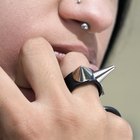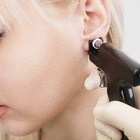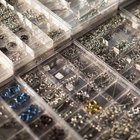
It is only natural that our bodies try to reject piercings, which are foreign bodies lodged in our skin. However, you can take measures before and after your piercing that will help prevent your body from rejecting it as if it were a splinter.
Before the Piercing
Decide what you want to have pierced. Cartilage piercings, like your ears or nose, have a much lower risk of rejection than skin piercings, such as in your belly-buttons or on your eyebrows.
Visit the place you plan on having the piercing done. Ask about the sterilization process for piercing tools, jewelry and the person doing the piercing. You may also want to ask about client requirements, see the piercer's portfolio and speak with other clients.
Choose proper jewelry. Titanium, glass, sterling silver and gold jewelry are less likely to be rejected than other metals. Smaller gauges are also more likely to be rejected. An experienced piercer should be able to help you determine the best selection for your particular piercing.
Schedule an appointment for your piercing, and ask your piercer for after-care instructions prior to your appointment. Make sure you have recommended care items, such as an antiseptic, in advance.
Schedule your piercing for a time when you will be able to leave it in for the recommended amount of time without disturbing it.
After the Piercing
Follow the after-care recommendations your piercer gives you closely.
Wash your hands before handling your piercing to reduce the risk of infection.
Minimize movement of the jewelry or irritation of the piercing through the day.
Leave your piercing in for the suggested amount of time, which may range from 4 to 12 weeks depending on the piercing. During the healing period, Avoid moving or handling your piercing during the healing period, avoid changing your jewelry. Keep hair products, skin care products, and similar foreign substances away from your piercing during this period.
Return to where you got your piercing for a follow-up after roughly a month.
Visit a health-care practitioner at the first sign of infection. Initial redness, swelling and discharge are normal, but prolonged pain, puss and foul odor can be signs of infection that may need special attention.
Related Articles

How to Get a Guiche Piercing

Information on Nose Piercings

How to Care for a Rook Piercing

How to Clean Nose Rings

How to Prepare for a Nose Piercing

How to Pierce Your Navel

Reactions to Nose Piercings

How to Get Rid of a Piercing That Won't ...

How Long to Wait Before Changing a Nose ...

What If They Make a Mistake When ...

How Do They Pierce Your Ears With ...

Homemade Recipe to Disinfect a Piercing

How to Drain a Cheek Piercing

How to Clean Smiley Piercings

How to Remove a Labret Piercing

Why Do People Pierce Their Ears?

Nose Hoop Vs. Stud

How Long Should I Wait to Get My Nose ...

Complications of Nipple Piercing

How to Change Pierced Earrings
Writer Bio
This article was written by the CareerTrend team, copy edited and fact checked through a multi-point auditing system, in efforts to ensure our readers only receive the best information. To submit your questions or ideas, or to simply learn more about CareerTrend, contact us [here](http://careertrend.com/about-us).